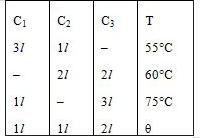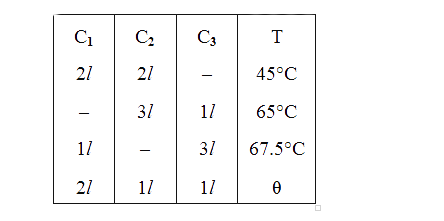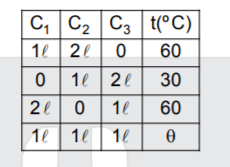Three containers C1,C2andC3 have water at different temperatures. The table below shows the final temperature T when different amounts water (given in liters) are taken from each container and mixed (assume no loss of heat during the process)

The value of θ (in .∘C to the nearest integer) is ------------
The correct Answer is:50
Step by step video, text & image solution for Three containers C_(1), C_(2) and C_(3) have water at different temperatures. The table below shows the final temperature T when different amounts water (given in liters) are taken from each container and mixed (assume no loss of heat during the process) The value of theta (in .^(@)C to the nearest integer) is ------------ by Physics experts to help you in doubts & scoring excellent marks in Class 12 exams.
Updated on:21/07/2023Topper's Solved these Questions
Similar Questions
Three containers C1,C2andC3 have water at different temperatures. The table below shows the final temperature T when different amounts of water (given in litres) are taken from each containers and mixed (assume no loss of heat during the process)

The value of θ (in ∘C to the nearest integer) is.......
View SolutionThree containers C1,C2 and C3 have water at different temperatures. The table below shows the final temperature T when different amounts of water (given in litres) are taken from each containers and mixed (assume no loss of heat during the process)

The value of (in °C to the nearest integer) is …….
View Solution
Knowledge Check
The temperature inside a refrigerator is t2 °C and the room temperature is t1 °C. The amount of heat delivered to the room for each joule of electrical energy consumed ideally will be
At∘1+273t∘1+t∘2Bt∘1+t∘2t∘1+273Ct∘1t∘1+t∘2Dt∘1−273t∘1+t∘2The temperature inside a refrigerator is t2 °C and the room temperature is t1 °C. The amount of heat delivered to the room for each joule of electrical energy consumed ideally will be
At∘1+273t∘1+t∘2Bt∘1+t∘2t∘1+273Ct∘1t∘1−t∘2Dt∘1−273t∘1+t∘2
There are three containers C1,C2 and C3 filled with same material at different constant temperature. When we mix then for different volume then we get some final temperature as shown in the below table. So find value of final temperature θ as shown in the table.

View SolutionTwo containers X and Y are filled with water at different temperature. When 10 g of water from container X is mixed with 20 g of water from container Y, the resultant temperature is found to be 20∘C. When 20 g of water from container X is mixed with 10 g of water from container Y, the resultant temperature is found to be 30∘C. Determine the inital temperature of water in container X and Y.
View SolutionTwo containers X and Y are filled with water at different temperature. When 10 g of water from container X is mixed with 20 g of water from container Y, the resultant temperature is found to be 20∘C. When 20 g of water from container X is mixed with 10 g of water from container Y, the resultant temperature is found to be 30∘C. Determine the inital temperature of water in container X and Y.
View SolutionTwo beaker A and B contain water at different temperatures .When 1 liter of water from beaker A is mixed with 2 litre of water from beaker B the equilibrium temperature is 16∘C and when 2 litre of water from beaker A then the equilibrium temperature is 14∘C .Determine the tempreature of water in the beaker A and B
View SolutionThe initial and final temperatures of water in a container are observed as 16±0.6∘C and 56±0.3∘C. What is the rise in the temperature of water.
View SolutionTwo beaker A and B contain water at different temperatures .When 1 liter of water from beaker A is mixed with 2 litre of water from beaker B the equilibrium temperature is 16∘C and when 2 litre of water from beaker A then the equilibrium temperature is 14∘C .Determine the tempreature of water in the beaker A and B
View Solution
